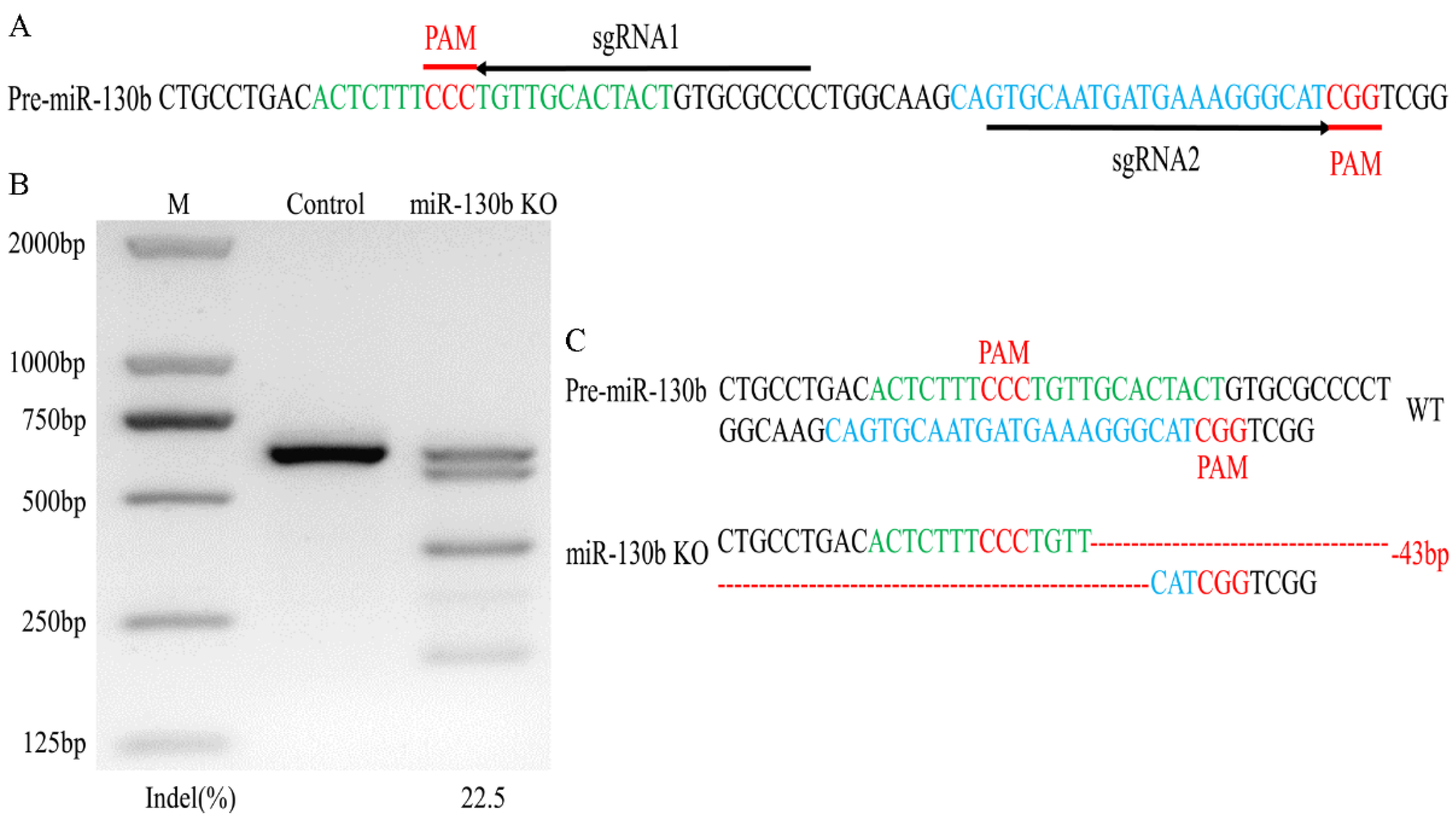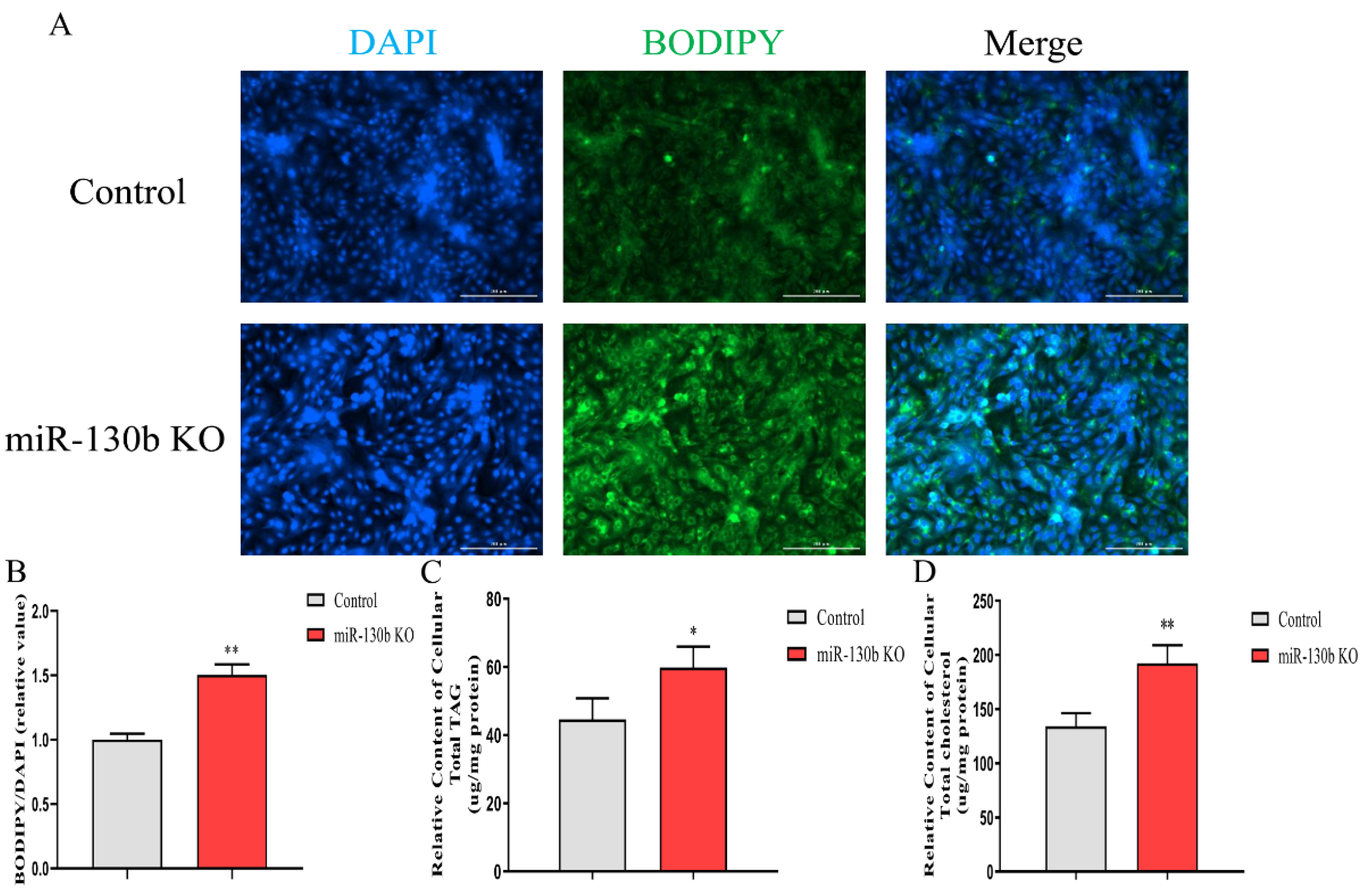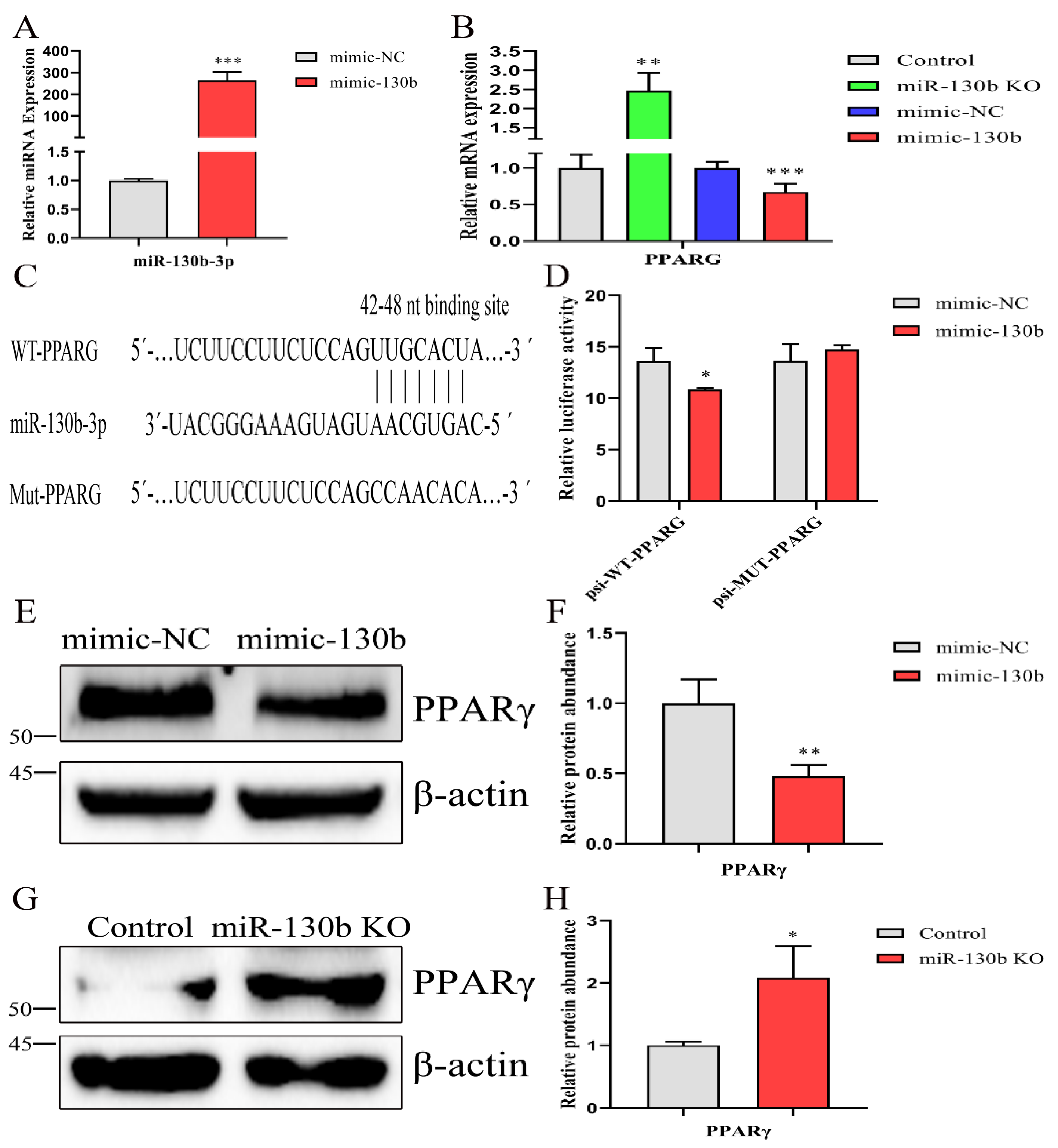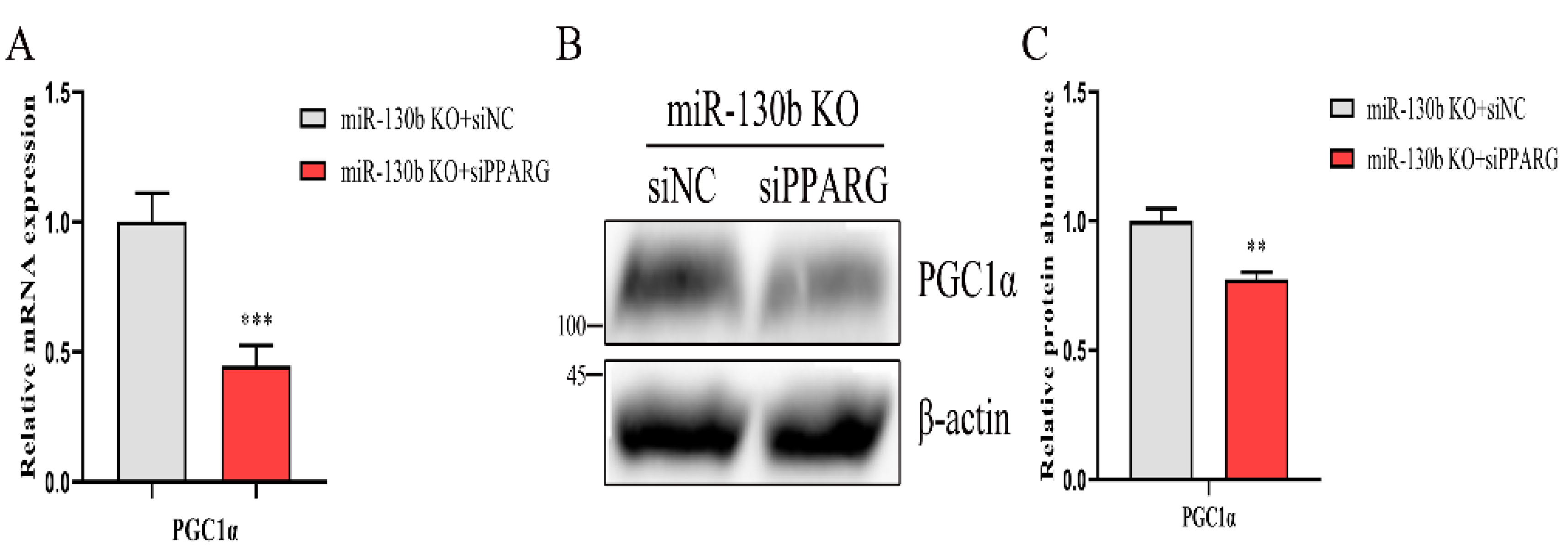CRISPR/Cas9-Mediated Knockout of miR-130b Affects Mono- and Polyunsaturated Fatty Acid Content via PPARG-PGC1α Axis in Goat Mammary Epithelial Cells
Abstract
:1. Introduction
2. Results
2.1. Gene-Editing Single Clone Selection and Analysis
2.2. Analysis of Off-Target Effect Induced by sgRNAs
2.3. Deletion of miR-130b Sequence Inhibits miR-130b-5p and 3p Expression and Increases PGC1α Abundance
2.4. Knockout of miR-130b Promotes Lipid Droplets, TAG, and Cholesterol Synthesis, and Affects Fatty Acid Composition
2.5. Abundance of Fatty Acid Metabolism-Related Gene Is Changed by Knocking out miR-130b
2.6. Inhibition of PGC1α Promotes Lipid Droplets, TAG, and Cholesterol Accumulation, and Affects Fatty Acid Composition
2.7. PPARG Is a Direct Target of miR-130b in Goat Mammary Epithelial Cells
2.8. Knockout of miR-130b Promotes Lipid Droplets, TAG, Cholesterol Synthesis and Affects Fatty Acid Composition Mainly via Targeting PPARG
2.9. Loss of PPARG Decreases the Expression of PGC1α in miR-130b Knockout Cells
3. Discussion
4. Materials and Methods
4.1. Ethics Statement
4.2. Mammary Collection and Cell
4.3. Construction of Cas9-sgRNAs and PPARG 3′UTR Vectors
4.4. Plasmid or RNA Transfection, Single Clone Selection, and T7EN1 Cleavage Assay
4.5. Analysis of Off-Target (OT) Effect in Single Clone
4.6. Reverse Transcription Quantitative PCR (RT-qPCR)
4.7. Western Blot
4.8. BODIPY™ 493/503 and DAPI Staining
4.9. Total TAG and Cholesterol Assays
4.10. Fatty Acid Composition Analysis
4.11. Luciferase Reporter Assay
4.12. Statistical Analysis
5. Conclusions
Supplementary Materials
Author Contributions
Funding
Institutional Review Board Statement
Informed Consent Statement
Data Availability Statement
Conflicts of Interest
References
- Clark, S.; Garcia, M.B.M. A 100-Year Review: Advances in goat milk research. J. Dairy Sci. 2017, 100, 10026–10044. [Google Scholar] [CrossRef] [PubMed]
- Luna, P.; Bach, A.; Juarez, M.; de la Fuente, M.A. Effect of a diet enriched in whole linseed and sunflower oil on goat milk fatty acid composition and conjugated linoleic acid isomer profile. J. Dairy Sci. 2008, 91, 20–28. [Google Scholar] [CrossRef] [PubMed] [Green Version]
- Joris, P.J.; Mensink, R.P. Role of cis-Monounsaturated Fatty Acids in the Prevention of Coronary Heart Disease. Curr. Atheroscler. Rep. 2016, 18, 38. [Google Scholar] [CrossRef] [PubMed] [Green Version]
- Wiktorowska-Owczarek, A.; Berezinska, M.; Nowak, J.Z. PUFAs: Structures, Metabolism and Functions. Adv. Clin. Exp. Med. 2015, 24, 931–941. [Google Scholar] [CrossRef]
- Pietrzak-Fiecko, R.; Kamelska-Sadowska, A.M. The Comparison of Nutritional Value of Human Milk with Other Mammals’ Milk. Nutrients 2020, 12, 1404. [Google Scholar] [CrossRef] [PubMed]
- Walther, T.C.; Chung, J.; Farese, R.V. Lipid Droplet Biogenesis. Annu. Rev. Cell Dev. Biol. 2017, 33, 491–510. [Google Scholar] [CrossRef] [PubMed] [Green Version]
- Schade, D.S.; Shey, L.; Eaton, R.P. Cholesterol Review: A Metabolically Important Molecule. Endocr. Pract. 2020, 26, 1514–1523. [Google Scholar] [CrossRef] [PubMed]
- Luo, J.; Yang, H.; Song, B.L. Mechanisms and regulation of cholesterol homeostasis. Nat. Rev. Mol. Cell Biol. 2020, 21, 225–245. [Google Scholar] [CrossRef] [PubMed]
- Ravaut, G.; Legiot, A.; Bergeron, K.F.; Mounier, C. Monounsaturated Fatty Acids in Obesity-Related Inflammation. Int. J. Mol. Sci. 2021, 22, 330. [Google Scholar] [CrossRef] [PubMed]
- Telle-Hansen, V.H.; Gaundal, L.; Myhrstad, M.C.W. Polyunsaturated Fatty Acids and Glycemic Control in Type 2 Diabetes. Nutrients 2019, 11, 1067. [Google Scholar] [CrossRef] [Green Version]
- Christie, W.W.; Harwood, J.L. Oxidation of polyunsaturated fatty acids to produce lipid mediators. Lipid Mediat. 2020, 64, 401–421. [Google Scholar]
- Jin, X.L.; Yang, J.X.; Li, Z.; Liu, H.Y.; Liu, J.X. Progress on the miRNA related with mammary gland development and lactation. Yi Chuan = Hered. 2013, 35, 695–702. [Google Scholar] [CrossRef]
- Wang, H.; Luo, J.; Chen, Z.; Cao, W.T.; Xu, H.F.; Gou, D.M.; Zhu, J.J. MicroRNA-24 can control triacylglycerol synthesis in goat mammary epithelial cells by targeting the fatty acid synthase gene. J. Dairy Sci. 2015, 98, 9001–9014. [Google Scholar] [CrossRef] [PubMed]
- Ma, Q.; Tan, Y.; Chen, X.; Chen, S.; Sun, Y.; Zhou, B. Regulation of the MAPK signaling pathway by miR-421-5p in rats under light pollution. Int. J. Mol. Med. 2018, 42, 3329–3343. [Google Scholar] [CrossRef] [PubMed] [Green Version]
- Wang, M.; Li, L.; Liu, R.; Song, Y.; Zhang, X.; Niu, W.; Kumar, A.K.; Guo, Z.; Hu, Z. Obesity-induced overexpression of miRNA-24 regulates cholesterol uptake and lipid metabolism by targeting SR-B1. Gene 2018, 668, 196–203. [Google Scholar] [CrossRef]
- Lan, X.; Wu, L.T.; Wu, N.; Chen, Q.; Li, Y.; Du, X.J.; Wei, C.X.; Feng, L.; Li, Y.Z.; Osoro, E.K.; et al. Long Noncoding RNA lnc-HC Regulates PPAR gamma-Mediated Hepatic Lipid Metabolism through miR-130b-3p. Mol. Ther.-Nucl. Acids 2019, 18, 954–965. [Google Scholar] [CrossRef] [PubMed] [Green Version]
- Ma, X.Y.; Wei, D.W.; Cheng, G.; Lj, S.J.; Wang, L.; Wang, Y.N.; Wang, X.Y.; Zhang, S.; Wang, H.B.; Zan, L.S. Bta-miR-130a/b regulates preadipocyte differentiation by targeting PPARG and CYP2U1 in beef cattle. Mol. Cell Probe 2018, 42, 10–17. [Google Scholar] [CrossRef]
- Zhang, J.; Jazii, F.R.; Haghighi, M.M.; Alvares, D.; Liu, L.; Khosraviani, N.; Adeli, K. miR-130b is a potent stimulator of hepatic very-low-density lipoprotein assembly and secretion via marked induction of microsomal triglyceride transfer protein. Am. J. Physiol. Endocrinol. Metab. 2020, 318, E262–E275. [Google Scholar] [CrossRef] [PubMed]
- Chen, Z.; Luo, J.; Ma, L.A.; Wang, H.; Cao, W.T.; Xu, H.F.; Zhu, J.J.; Sun, Y.T.; Li, J.; Yao, D.W.; et al. MiR130b-Regulation of PPAR gamma Coactivator-1 alpha Suppresses Fat Metabolism in Goat Mammary Epithelial Cells. PLoS ONE 2015, 10, e0142809. [Google Scholar]
- Cheng, C.F.; Ku, H.C.; Lin, H. PGC-1 as a Pivotal Factor in Lipid and Metabolic Regulation. Int. J. Mol. Sci. 2018, 19, 3447. [Google Scholar] [CrossRef] [Green Version]
- Huang, T.Y.; Zheng, D.H.; Houmard, J.A.; Brault, J.J.; Hickner, R.C.; Cortright, R.N. Overexpression of PGC-1 alpha increases peroxisomal activity and mitochondrial fatty acid oxidation in human primary myotubes. Am. J. Physiol.-Endoc. 2017, 312, E253–E263. [Google Scholar]
- Tobina, T.; Mori, Y.; Doi, Y.; Nakayama, F.; Kiyonaga, A.; Tanaka, H. Peroxisome proliferator-activated receptor gamma co-activator 1 gene Gly482Ser polymorphism is associated with the response of low-density lipoprotein cholesterol concentrations to exercise training in elderly Japanese. J. Physiol. Sci. 2017, 67, 595–602. [Google Scholar] [CrossRef] [PubMed]
- Chen, P.; Zhao, H.; Wu, M.; He, S.; Yuan, T.; Yi, X.; Liu, S.; Pan, Y.; Li, Q.; Wang, S.; et al. A novel 17 bp InDel polymorphism within the PPARGC1A gene is significantly associated with growth traits in sheep. Anim. Biotechnol. 2020, 3, 1–9. [Google Scholar] [CrossRef]
- Barton, L.; Bures, D.; Kott, T.; Rehak, D. Associations of polymorphisms in bovine DGAT1, FABP4, FASN, and PPARGC1A genes with intramuscular fat content and the fatty acid composition of muscle and subcutaneous fat in Fleckvieh bulls. Meat Sci. 2016, 114, 18–23. [Google Scholar] [CrossRef] [PubMed]
- Wafer, R.; Tandon, P.; Minchin, J.E.N. The Role of Peroxisome Proliferator-Activated Receptor Gamma (PPARG) in Adipogenesis: Applying Knowledge from the Fish Aquaculture Industry to Biomedical Research. Front. Endocrinol. 2017, 8, 102. [Google Scholar] [CrossRef] [Green Version]
- Xu, B.M.; Xiao, L.; Kang, C.M.; Ding, L.; Guo, F.X.; Li, P.; Lu, Z.F.; Wu, Q.; Xu, Y.J.; Bai, H.L.; et al. LncRNA AC096664.3/PPAR-gamma/ABCG1-dependent signal transduction pathway contributes to the regulation of cholesterol homeostasis. J. Cell. Biochem. 2019, 120, 13775–13782. [Google Scholar] [CrossRef] [PubMed]
- Jester, J.V.; Potma, E.; Brown, D.J. PPAR gamma Regulates Mouse Meibocyte Differentiation and Lipid Synthesis. Ocul. Surf. 2016, 14, 484–494. [Google Scholar] [CrossRef] [Green Version]
- Kim, S.W.; Rho, C.R.; Kim, J.; Xie, Y.L.; Prince, R.C.; Mustafa, K.; Potma, E.O.; Brown, D.J.; Jester, J.V. Eicosapentaenoic acid (EPA) activates PPAR gamma signaling leading to cell cycle exit, lipid accumulation, and autophagy in human meibomian gland epithelial cells (hMGEC). Ocul. Surf. 2020, 18, 427–437. [Google Scholar] [CrossRef] [PubMed]
- Ylonen, S.K.; Salminen, I.; Lyssenko, V.; Virtanen, S.M.; Groop, L.; Aro, A.; Saloranta, C.; Botnia Research, G. The Pro12Ala polymorphism of the PPAR-gamma2 gene affects associations of fish intake and marine n-3 fatty acids with glucose metabolism. Eur. J. Clin. Nutr. 2008, 62, 1432–1439. [Google Scholar] [CrossRef] [PubMed] [Green Version]
- Hondares, E.; Mora, O.; Yubero, P.; Rodriguez de la Concepcion, M.; Iglesias, R.; Giralt, M.; Villarroya, F. Thiazolidinediones and rexinoids induce peroxisome proliferator-activated receptor-coactivator (PGC)-1alpha gene transcription: An autoregulatory loop controls PGC-1alpha expression in adipocytes via peroxisome proliferator-activated receptor-gamma coactivation. Endocrinology 2006, 147, 2829–2838. [Google Scholar]
- Jacquet, K.; Vidal-Cruchez, O.; Rezzonico, R.; Nicolini, V.J.; Mograbi, B.; Hofman, P.; Vassaux, G.; Mari, B.; Brest, P. New technologies for improved relevance in miRNA research. Trends Genet. 2021, 37, 1060–1063. [Google Scholar] [CrossRef] [PubMed]
- Lin, Y.; Zhu, Y.; Cui, Y.; Chen, R.; Chen, Z.; Li, G.; Fan, M.; Chen, J.; Li, Y.; Guo, X.; et al. Derepression of specific miRNA-target genes in rice using CRISPR/Cas9. J. Exp. Bot. 2021, 72, 7067–7077. [Google Scholar] [CrossRef] [PubMed]
- Yeligar, S.M.; Kang, B.Y.; Bijli, K.M.; Kleinhenz, J.M.; Murphy, T.C.; Torres, G.; San Martin, A.; Sutliff, R.L.; Hart, C.M. PPARgamma Regulates Mitochondrial Structure and Function and Human Pulmonary Artery Smooth Muscle Cell Proliferation. Am. J. Respir. Cell Mol. Biol. 2018, 58, 648–657. [Google Scholar] [CrossRef]
- Evangelista, A.F.; Oliveira, R.J.; Silva, V.A.O.; Vieira, R.A.D.C.; Reis, R.M.; Marques, M.M.C. Integrated analysis of mRNA and miRNA profiles revealed the role of miR-193 and miR-210 as potential regulatory biomarkers in different molecular subtypes of breast cancer. BMC Cancer 2021, 21, 76. [Google Scholar] [CrossRef] [PubMed]
- Nakagawa, A.; Nakajima, T.; Azuma, M. Tear miRNA expression analysis reveals miR-203 as a potential regulator of corneal epithelial cells. BMC Ophthalmol. 2021, 21, 377. [Google Scholar] [CrossRef] [PubMed]
- Chang, H.; Yi, B.; Ma, R.X.; Zhang, X.G.; Zhao, H.Y.; Xi, Y.G. CRISPR/cas9, a novel genomic tool to knock down microRNA in vitro and in vivo. Sci. Rep. 2016, 6, 22312. [Google Scholar] [CrossRef] [PubMed] [Green Version]
- Reichel, M.; Li, Y.J.; Li, J.Y.; Millar, A.A. Inhibiting plant microRNA activity: Molecular SPONGEs, target MIMICs and STTMs all display variable efficacies against target microRNAs. Plant Biotechnol. J. 2015, 13, 915–926. [Google Scholar] [CrossRef] [Green Version]
- Huang, L.; Tian, H.B.; Luo, J.; Song, N.; Wu, J. CRISPR/Cas9 Based Knockout of miR-145 Affects Intracellular Fatty Acid Metabolism by Targeting INSIG1 in Goat Mammary Epithelial Cells. J. Agric. Food Chem. 2020, 68, 5138–5146. [Google Scholar] [CrossRef]
- Casini, A.; Olivieri, M.; Petris, G.; Montagna, C.; Reginato, G.; Maule, G.; Lorenzin, F.; Prandi, D.; Romanel, A.; Demichelis, F.; et al. A highly specific SpCas9 variant is identified by in vivo screening in yeast. Nat. Biotechnol. 2018, 36, 265–271. [Google Scholar] [CrossRef] [PubMed]
- Lu, C.; Pang, D.X.; Li, M.J.; Yuan, H.M.; Yu, T.T.; Huang, P.X.; Li, J.N.; Chen, X.; Jiao, H.P.; Xie, Z.C.; et al. CRISPR/Cas9-Mediated Hitchhike Expression of Functional shRNAs at the Porcine miR-17-92 Cluster. Cells 2019, 8, 113. [Google Scholar] [CrossRef] [Green Version]
- Kim, Y.K.; Kim, B.; Kim, V.N. Re-evaluation of the roles of DROSHA, Export in 5, and DICER in microRNA biogenesis. Proc. Natl. Acad. Sci. USA 2016, 113, E1881–E1889. [Google Scholar] [CrossRef] [PubMed] [Green Version]
- Treiber, T.; Treiber, N.; Meister, G. Regulation of microRNA biogenesis and its crosstalk with other cellular pathways. Nat. Rev. Mol. Cell Biol. 2019, 20, 5–20. [Google Scholar] [CrossRef] [PubMed]
- Bartel, D.P. Metazoan MicroRNAs. Cell 2018, 173, 20–51. [Google Scholar] [CrossRef] [PubMed] [Green Version]
- Lataniotis, L.; Albrecht, A.; Kok, F.O.; Monfries, C.A.L.; Benedetti, L.; Lawson, N.D.; Hughes, S.M.; Steinhofel, K.; Mayr, M.; Zampetaki, A. CRISPR/Cas9 editing reveals novel mechanisms of clustered microRNA regulation and function. Sci. Rep. 2017, 7, 8585. [Google Scholar] [CrossRef] [Green Version]
- Pan, S.F.; Cui, Y.X.; Dong, X.; Zhang, T.J.; Xing, H. MicroRNA-130b attenuates dexamethasone-induced increase of lipid accumulation in porcine preadipocytes by suppressing PPAR-gamma expression. Oncotarget 2017, 8, 87928–87943. [Google Scholar] [CrossRef] [Green Version]
- Pan, S.F.; Yang, X.J.; Jia, Y.M.; Li, Y.; Chen, R.R.; Wang, M.; Cai, D.M.; Zhao, R.Q. Intravenous injection of microvesicle-delivery miR-130b alleviates high-fat diet-induced obesity in C57BL/6 mice through translational repression of PPAR-gamma. J. Biomed. Sci. 2015, 22, 86. [Google Scholar] [CrossRef] [Green Version]
- Alves-Bezerra, M.; Cohen, D.E. Triglyceride Metabolism in the Liver. Compr. Physiol. 2018, 8, 1–22. [Google Scholar]
- Bionaz, M.; Loor, J.J. Gene networks driving bovine milk fat synthesis during the lactation cycle. BMC Genom. 2008, 9, 366. [Google Scholar] [CrossRef] [Green Version]
- Chong, B.M.; Reigan, P.; Mayle-Combs, K.D.; Orlicky, D.J.; McManaman, J.L. Determinants of adipophilin function in milk lipid formation and secretion. Trends Endocrinol. Metab. 2011, 22, 211–217. [Google Scholar] [CrossRef] [Green Version]
- Luo, J.; Zhu, J.J.; Sun, Y.T.; Shi, H.B.; Li, J. Inhibitions of FASN suppress triglyceride synthesis via the control of malonyl-CoA in goat mammary epithelial cells. Anim. Prod. Sci. 2017, 57, 1624–1630. [Google Scholar] [CrossRef]
- Fievez, V.; Vlaeminck, B.; Dhanoa, M.S.; Dewhurst, R.J. Use of principal component analysis to investigate the origin of heptadecenoic and conjugated linoleic acids in milk. J. Dairy Sci. 2003, 86, 4047–4053. [Google Scholar] [CrossRef]
- Green, C.D.; Ozguden-Akkoc, C.G.; Wang, Y.; Jump, D.B.; Olson, L.K. Role of fatty acid elongases in determination of de novo synthesized monounsaturated fatty acid species. J. Lipid Res. 2010, 51, 1871–1877. [Google Scholar] [CrossRef] [PubMed] [Green Version]
- Zhang, J.Y.; Kothapalli, K.S.D.; Brenna, J.T. Desaturase and elongase-limiting endogenous long-chain polyunsaturated fatty acid biosynthesis. Curr. Opin. Clin. Nutr. 2016, 19, 103–110. [Google Scholar] [CrossRef] [PubMed]
- Lukaszuk, B.; Kurek, K.; Miklosz, A.; Zendzian-Piotrowska, M.; Chabowski, A. The Role of PGC-1alpha in the Development of Insulin Resistance in Skeletal Muscle—Revisited. Cell. Physiol. Biochem. 2015, 37, 2288–2296. [Google Scholar] [CrossRef] [PubMed]
- Rius-Perez, S.; Torres-Cuevas, I.; Millan, I.; Ortega, A.L.; Perez, S. PGC-1 alpha, Inflammation, and Oxidative Stress: An Integrative View in Metabolism. Oxid. Med. Cell Longev. 2020, 2020, 1452696. [Google Scholar] [CrossRef] [PubMed] [Green Version]
- Chen, Z.; Luo, J.; Sun, S.; Cao, D.Y.; Shi, H.P.; Loor, J.J. miR-148a and miR-17-5p synergistically regulate milk TAG synthesis via PPARGC1A and PPARA in goat mammary epithelial cells. RNA Biol. 2017, 14, 326–338. [Google Scholar] [CrossRef] [PubMed] [Green Version]
- Koves, T.R.; Sparks, L.M.; Kovalik, J.P.; Mosedale, M.; Arumugam, R.; DeBalsi, K.L.; Everingham, K.; Thorne, L.; Phielix, E.; Meex, R.C.; et al. PPARgamma coactivator-1alpha contributes to exercise-induced regulation of intramuscular lipid droplet programming in mice and humans. J. Lipid Res. 2013, 54, 522–534. [Google Scholar] [CrossRef] [Green Version]
- Espinoza, D.O.; Boros, L.G.; Crunkhorn, S.; Gami, H.; Patti, M.E. Dual modulation of both lipid oxidation and synthesis by peroxisome proliferator-activated receptor-gamma coactivator-1alpha and -1beta in cultured myotubes. FASEB J. 2010, 24, 1003–1014. [Google Scholar] [CrossRef] [Green Version]
- Janani, C.; Ranjitha Kumari, B.D. PPAR gamma gene—A review. Diabetes Metab. Syndr. 2015, 9, 46–50. [Google Scholar] [CrossRef] [PubMed]
- Yu, K.; Shi, H.B.; Luo, J.; Li, J.; Zhao, W.S.; Tian, H.B.; Shi, H.P. PPARG Modulated Lipid Accumulation in Dairy GMEC via Regulation of ADRP Gene. J. Cell. Biochem. 2015, 116, 192–201. [Google Scholar]
- Zhang, M.; Zhou, Z.Q.; Wang, J.G.; Li, S.F. MiR-130b promotes obesity associated adipose tissue inflammation and insulin resistance in diabetes mice through alleviating M2 macrophage polarization via repression of PPAR-gamma. Immunol. Lett. 2016, 180, 1–8. [Google Scholar] [CrossRef] [PubMed]
- Yan, Y.; Qin, D.; Hu, B.; Zhang, C.J.; Liu, S.H.; Wu, D.D.; Huang, W.D.; Huang, X.X.; Wang, L.Q.; Chen, X.M.; et al. Deletion of miR-126a Promotes Hepatic Aging and Inflammation in a Mouse Model of Cholestasis. Mol. Ther.-Nucl. Acids 2019, 16, 494–504. [Google Scholar] [CrossRef] [Green Version]
- Wang, Y.; Li, X.; Liu, W.; Li, B.; Chen, D.; Hu, F.; Wang, L.; Liu, X.M.; Cui, R.; Liu, R. MicroRNA-1205, encoded on chromosome 8q24, targets EGLN3 to induce cell growth and contributes to risk of castration-resistant prostate cancer. Oncogene 2019, 38, 4820–4834. [Google Scholar] [CrossRef] [PubMed]
- Song, N.; Chen, Y.; Luo, J.; Huang, L.; Tian, H.; Li, C.; Loor, J.J. Negative regulation of alphaS1-casein (CSN1S1) improves beta-casein content and reduces allergy potential in goat milk. J. Dairy Sci. 2020, 103, 9561–9572. [Google Scholar] [CrossRef]
- Tian, H.B.; Luo, J.; Zhang, Z.F.; Wu, J.; Zhang, T.Y.; Busato, S.; Huang, L.; Song, N.; Bionaz, M. CRISPR/Cas9-mediated Stearoyl-CoA Desaturase 1 (SCD1) Deficiency Affects Fatty Acid Metabolism in Goat Mammary Epithelial Cells. J. Agr. Food Chem. 2018, 66, 10041–10052. [Google Scholar] [CrossRef]
- Niu, Y.Q.; Zhang, L.M.; Qiu, H.L.; Wu, Y.K.; Wang, Z.W.; Zai, Y.J.; Liu, L.; Qu, J.L.; Kang, K.; Gou, D.M. An improved method for detecting circulating microRNAs with S-Poly(T) Plus real-time PCR. Sci. Rep. 2015, 5, 15100. [Google Scholar] [CrossRef] [PubMed] [Green Version]
- Zhu, J.J.; Luo, J.; Wang, W.; Yu, K.; Wang, H.B.; Shi, H.B.; Sun, Y.T.; Lin, X.Z.; Li, J. Inhibition of FASN reduces the synthesis of medium-chain fatty acids in goat mammary gland. Animal 2014, 8, 1469–1478. [Google Scholar] [CrossRef] [PubMed]







| Fatty Acid (%) | Control | miR-130b KO |
|---|---|---|
| C14:0 | 4.01 ± 0.00 B | 6.36 ± 0.56 A |
| C15:0 | 0.67 ± 0.03 b | 0.73 ± 0.00 a |
| C16:0 | 46.54 ± 0.23 a | 46.03 ± 0.12 b |
| C16:1 | 1.69 ± 0.04 A | 1.37 ± 0.00 B |
| C17:0 | 1.10 ± 0.05 B | 1.15 ± 0.01 A |
| C17:1 | 0.44 ± 0.06 a | 0.41 ± 0.02 b |
| C18:0 | 27.84 ± 0.10 a | 27.14 ± 0.26 b |
| C18:1 | 12.93 ± 0.08 A | 12.64 ± 0.05 B |
| C18:2 | 1.35 ± 0.00 A | 1.18 ± 0.04 B |
| C20:0 | 0.32 ± 0.04 | 0.29 ± 0.01 |
| C20:3 | 0.52 ± 0.01 b | 0.49 ± 0.04 a |
| C20:4 | 1.60 ± 0.11 a | 1.38 ± 0.08 b |
| C20:5 | 0.53 ± 0.05 B | 0.45 ± 0.02 A |
| C22:6 | 0.46 ± 0.02 A | 0.38 ± 0.01 B |
| SFA | 80.48 | 81.70 |
| MUFA | 15.06 | 14.41 |
| PUFA | 4.46 | 3.89 |
| Fatty Acid (%) | Control + siNC | Control + siPPARG | miR-130b KO + siNC | miR-130b KO + siPPARG |
|---|---|---|---|---|
| C14:0 | 3.58 ± 0.32 a | 3.08 ± 0.09 b | 3.76 ± 0.13 a | 3.71 ± 0.18 a |
| C15:0 | 0.43 ± 0.01 a | 0.45 ± 0.01 a | 0.36 ± 0.01 c | 0.39 ± 0.01 b |
| C16:0 | 51.29 ± 0.60 b | 52.47 ± 0.14 a | 50.48 ± 0.46 b | 50.37 ± 0.55 b |
| C16:1 | 2.11 ± 0.07 a | 2.05 ± 0.07 a | 1.88 ± 0.03 b | 1.86 ± 0.09 b |
| C17:0 | 0.72 ± 0.02 b | 0.79 ± 0.01 a | 0.61 ± 0.03 c | 0.71 ± 0.02b b |
| C17:1 | 0.43 ± 0.01 ab | 0.43 ± 0.02 a | 0.37 ± 0.01 c | 0.39 ± 0.03 bc |
| C18:0 | 21.95 ± 0.49 b | 22.98 ± 0.27 a | 22.19 ± 0.38 ab | 22.98 ± 0.73 a |
| C18:1 | 15.38 ± 0.19 c | 14.09 ± 0.27 d | 16.71 ± 0.14 a | 15.78 ± 0.13 b |
| C18:2 | 0.98 ± 0.03 a | 0.91 ± 0.03 b | 0.83 ± 0.01 c | 0.88 ± 0.01 b |
| C20:0 | 0.31 ± 0.02 b | 0.25 ± 0.02 c | 0.37 ± 0.02 a | 0.38 ± 0.03 a |
| C20:3 | 0.37 ± 0.03 ab | 0.35 ± 0.01 b | 0.39 ± 0.02 a | 0.41 ± 0.02 a |
| C20:4 | 1.59 ± 0.08 a | 1.42 ± 0.05 b | 1.37 ± 0.03 b | 1.43 ± 0.07 b |
| C20:5 | 0.54 ± 0.01 a | 0.51 ± 0.02 a | 0.34 ± 0.02 b | 0.36 ± 0.01 b |
| C22:6 | 0.32 ± 0.00 a | 0.22 ± 0.01 b | 0.33 ± 0.02 a | 0.34 ± 0.01 a |
| SFA | 78.28 | 80.01 | 77.28 | 78.54 |
| MUFA | 17.91 | 16.58 | 18.97 | 18.03 |
| PUFA | 3.81 | 3.41 | 3.25 | 3.43 |
Publisher’s Note: MDPI stays neutral with regard to jurisdictional claims in published maps and institutional affiliations. |
© 2022 by the authors. Licensee MDPI, Basel, Switzerland. This article is an open access article distributed under the terms and conditions of the Creative Commons Attribution (CC BY) license (https://creativecommons.org/licenses/by/4.0/).
Share and Cite
Huang, L.; Luo, J.; Song, N.; Gao, W.; Zhu, L.; Yao, W. CRISPR/Cas9-Mediated Knockout of miR-130b Affects Mono- and Polyunsaturated Fatty Acid Content via PPARG-PGC1α Axis in Goat Mammary Epithelial Cells. Int. J. Mol. Sci. 2022, 23, 3640. https://doi.org/10.3390/ijms23073640
Huang L, Luo J, Song N, Gao W, Zhu L, Yao W. CRISPR/Cas9-Mediated Knockout of miR-130b Affects Mono- and Polyunsaturated Fatty Acid Content via PPARG-PGC1α Axis in Goat Mammary Epithelial Cells. International Journal of Molecular Sciences. 2022; 23(7):3640. https://doi.org/10.3390/ijms23073640
Chicago/Turabian StyleHuang, Lian, Jun Luo, Ning Song, Wenchang Gao, Lu Zhu, and Weiwei Yao. 2022. "CRISPR/Cas9-Mediated Knockout of miR-130b Affects Mono- and Polyunsaturated Fatty Acid Content via PPARG-PGC1α Axis in Goat Mammary Epithelial Cells" International Journal of Molecular Sciences 23, no. 7: 3640. https://doi.org/10.3390/ijms23073640







